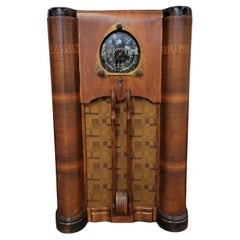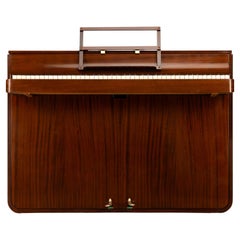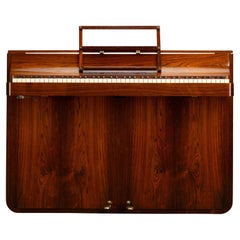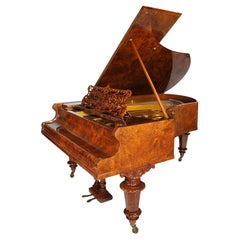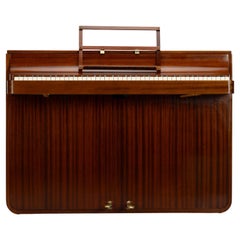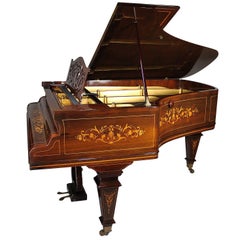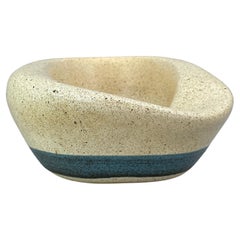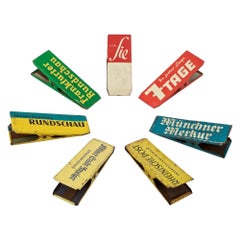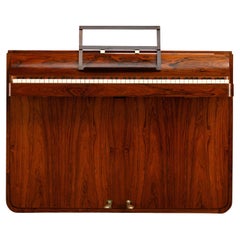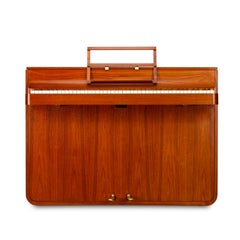Veneer Musical Instruments
to
3
4
3
8
4
1
1
2
6
2
4
1
3
1
8
3
3
3
3
6
3
3
1
1
8
8
8
1
1
1
1
1
Technique: Veneer
Zenith Console Radio Model 9-S-262
Located in Fulton, CA
A Philco Model 9-S-262 console radio with multiple band dial. Circa. 1938. All electrical components and speaker intact. Beautiful dial, grill cloth and finish. Radio turns on, dial ...
Category
Early 20th Century American Art Deco Veneer Musical Instruments
Materials
Walnut
$1,250 Sale Price
24% Off
Danish Design Midcentury Pianette by Louis Zwicki in Mahogany, 1950s
Located in Breda, Netherlands
Danish design
A rare Danish midcentury pianette made of mahogany. It is called pianette due to the 82 keys rather than the standard 88 of a full size piano. This pianette is made by ...
Category
1950s Danish Mid-Century Modern Vintage Veneer Musical Instruments
Materials
Mahogany
Danish Design Midcentury Pianette by Louis Zwicki in Rosewood, 1960s
Located in Breda, Netherlands
Danish design
A rare Danish midcentury pianette made of rosewood. It is called pianette due to the 82 keys rather than the standard 88 of a full size piano. This pianette is made by ...
Category
1960s Danish Mid-Century Modern Vintage Veneer Musical Instruments
Materials
Rosewood
A German 19th Century Louis XVI Style Burr Walnut Bechstein Concert Grand Piano
By Bechstein Piano Company
Located in Los Angeles, CA
A Very Fine German 19th Century Louis XVI Style Burr Walnut Bechstein Concert Grand Piano, Serial No. 5655. The beautifully crafted Grand piano, raised on three tapered barrel shaped legs, with an intricately carved ornate music desk and original keys. Circa: 1872.
Length: 80 inches (203.2 cm)
Width: 59 inches: (149.9 cm)
Height (top closed): 38 5/8 inches (98.1 cm)
C. Bechstein Pianofortefabrik
C. Bechstein Pianofortefabrik AG (also known as Bechstein) is a German manufacturer of pianos, established in 1853 by Carl Bechstein.
Before Bechstein
Young Carl Bechstein studied and worked in France and England as a piano craftsman, before he became an independent piano maker. His first pianos were made for other companies.
C. Bechstein
C. Bechstein piano factory was founded on 1 October 1853 by Carl Bechstein in Berlin, Germany.
Carl Bechstein set out to manufacture a piano able to withstand the great demands imposed on the instrument by the virtuosi of the time, such as Franz Liszt. In 1857, Hans von Bülow (Liszt's son-in-law) gave the first public performance on a Bechstein grand piano by performing Liszt's Piano Sonata in B minor in Berlin
By 1870, with endorsements from Franz Liszt and Hans von Bülow, Bechstein pianos had become a staple in many concert halls and private mansions. By that time three piano makers, all of which were founded in 1853, became established as the industry leaders across the world: Bechstein, Blüthner and Steinway & Sons.
In 1881 Bechstein began supplying pianos to Queen Victoria. A gilded art-case piano was delivered to Buckingham Palace, followed by several more Bechstein pianos to Windsor Castle and other royal residences. By January 1886 they were among the piano manufacturers holding a Royal Warrant as a supplier to the Queen. Several British embassies across the world acquired Bechstein pianos.
In 1885, Bechstein opened a branch in London, that eventually grew to become the largest showroom and dealership in Europe. By 1890 showrooms had been opened in Paris, Vienna, and Saint Petersburg. On 31 May 1901, Bechstein Hall, built at a cost of £100,000, was opened next to the company's London showroom at 36-40 Wigmore Street. Between 1901 and 1914, C. Bechstein was the largest piano dealership in London. At that time, Bechstein was patronized by the tsars of Russia, the royal families of Spain, Belgium, the Netherlands, Italy, Sweden, Norway, Austria and Denmark, and other royalty and aristocracy. The list of royal clients of Bechstein may be found on the soundboard of vintage Bechstein pianos made before the Second World War. The list is part of the original Bechstein trademark logo; it can be seen under the strings in the center of a piano's soundboard.
The signature of Carl Bechstein
The years from the 1870s through 1914 brought Bechstein their most dramatic increase in sales. In 1880 a second Bechstein factory was opened in Berlin, and the third factory was opened in 1897 in Berlin-Kreuzberg. Production reached 3,700 pianos annually in 1900, and 4,600 in 1910, making Bechstein the largest German manufacturer of high-end pianos. At that time, about three quarters of production went to international markets, especially Britain and the Commonwealth, and Russia.
Carl Bechstein died in 1900, and the Bechstein company continued to operate under the management of his sons.
Between 1900 and 1914 C. Bechstein was one of the leading piano makers in the world, employing 1,200 craftsmen and workers by 1913 and making five thousand pianos per year.
First World War
C. Bechstein suffered huge property losses in London, Paris, and St. Petersburg during World War I. The largest loss was in London. Although the company's position in the United Kingdom was initially unaffected, with the company still listed as holding a Royal Warrant in January 1915, Warrants to both King George V, and his wife Queen Mary were cancelled on 13 April 1915. Bechstein was not the only musical concern to be affected by growing anti-German sentiment: there were earlier attempts, led by William Boosey, to boycott German music altogether. In 1915, despite being a Baronet and Privy Counsellor, Sir Edgar Speyer, who was then funding the Proms, was forced to leave the country. Following the passing of the Trading with the Enemy Amendment Act 1916 the British arm of the company was wound-up on 5 June 1916, all Bechstein property, including the concert hall and showrooms full of pianos, were seized as "enemy property" and closed. In 1916 the hall was sold as alien property at auction to Debenhams for £56,500. It was renamed Wigmore Hall, and then re-opened under the new name in 1917. All 137 Bechstein pianos at the Bechstein showrooms were confiscated too, and became property of the new owner of the Hall. After a dispute with his brother, Edwin Bechstein left the company and was paid off.
Eventually the Bechstein factory resumed full-scale production during the 1920s. At that time, technical innovations and inventions of new materials and tools, as well as improvements in piano design and construction, had allowed Bechstein to become one of the leading piano makers again.
The most successful models were the updated "A"-185 and "B"-208 grand pianos. The upright pianos became more popular after the war, and C. Bechstein were successful with its upright pianos Model-8 and Model-9, both of which have been considered the finest upright pianos.
As the company was changed into a joint-stock company 1923, Edwin Bechstein and his wife Helene, bought themselves back into the company as shareholders.
In 1930 the company collaborated with German electrical goods manufacturer Siemens under Nobel laureate Walther Nernst to produce one of the first electric pianos...
Category
19th Century German Louis XVI Antique Veneer Musical Instruments
Materials
Bronze
$34,850 Sale Price
53% Off
Danish Design Midcentury Pianette by Louis Zwicki in Mahogany, 1950s
Located in Breda, Netherlands
Danish design
A rare Danish midcentury pianette made of mahogany. It is called pianette due to the 82 keys rather than the standard 88 of a full size piano. This pianette is made by ...
Category
1950s Danish Mid-Century Modern Vintage Veneer Musical Instruments
Materials
Mahogany
19th Century Louis XIV Style Marquetry Baby Grand Piano by Collard & Collard
By Collard & Collard
Located in Los Angeles, CA
A very fine Anglo-French 19th century rosewood, palisander, amboyna and satinwood marquetry (inlaid) art-case baby grand piano, the works by "Collard & Collard". The intricately deco...
Category
Late 19th Century English Neoclassical Revival Antique Veneer Musical Instruments
Materials
Bronze
$75,600 Sale Price
20% Off
Record Player Cabinet by Carlo Hauner and Martin Eisler, 1955, Mid-Century
Located in New York, NY
This Caviuna Record Player was produced by Forma S.A. Móveis e Objetos de Arte in the 1950s, whose designs were made by Carlo Hauner and Martin Eisler.
This typology was part of the storage furniture from the period, appearing in several interior projects published in the most known design and lifestyle magazines. It was part of modular furniture, commonly assembled with shelves, flower boxes, and bar compartments.
Extraordinarily complex and hand-crafted, the wood pieces produced by Forma Móveis e Objetos de Arte in Brazil in the 1950s have unique construction details, very distinctive of any production of the time in Brazil.
This Record Player is composed of two hanging doors...
Category
1950s Brazilian Mid-Century Modern Vintage Veneer Musical Instruments
Materials
Hardwood
Wonderful Turn of the Century Gilt Bronze Mounted Six-Leg Grand Erard Piano
Located in Long Island City, NY
A wonderful turn of the century gilt bronze mounted Louis XVI style six-leg Grand Erard piano
Beautiful satinwood veneer, bronze mounts, standing on six legs centered by a stretcher.
The movement stamped with Erard serial number 93712 and patent stamps, the interior of the case further stamped F. TURBEC/A LEMOINE, and M. BECKER.
Erard is the oldest and most prestigious French piano manufacturer. The firm was founded by Sebastian Erard...
Category
Early 1900s French Belle Époque Antique Veneer Musical Instruments
Materials
Bronze, Ormolu
Related Items
1960s Mid-Century Organic Pottery Table Dish Painted Geometric Design
Located in Hyattsville, MD
Large glazed pottery centerpiece with geometric dot and stripe, hand-painted decorations, signed.
Category
1960s Israeli Mid-Century Modern Vintage Veneer Musical Instruments
Materials
Stoneware
$1,276 Sale Price
20% Off
H 3.75 in W 7.75 in D 6.5 in
1950s German Newspaper Advertising Tin Clips Midcentury Graphic Design Set
Located in Hyattsville, MD
Small collection of light duty metal clips, from German newspapers. Silkscreen on thin metal. All working.
Kölnische Zeitung (Cologne Gazette)
Frankfurter Rundschau
Rheinische P...
Category
1950s German Mid-Century Modern Vintage Veneer Musical Instruments
Materials
Tin
$764 Sale Price / set
20% Off
H 1 in W 4 in D 1.25 in
1950s Zenith Brown Bakelite Portable Radio Nonworking
By Zenith
Located in Chula Vista, CA
Vintage Zenith portable radio
9 h x 14.5 w x 8.75
Bakelite cover with rubber handle.
Original knobs. Minos scuffs present.
Tested and not working.
Review images listed.
Category
1950s Mid-Century Modern Vintage Veneer Musical Instruments
Materials
Bakelite
1960s Emil Milan Rosewood Brass Table Lighter Sculpture American Studio Craft
By Emil Milan
Located in Hyattsville, MD
Wonderful and rare large table lighter by Emil Milan in E.T. rosewood. Lighter is not functioning, will need flint and fuel.
Category
1960s American Mid-Century Modern Vintage Veneer Musical Instruments
Materials
Wood
$2,800 Sale Price
20% Off
H 8 in W 2.32 in D 3 in
Vintage Silvertone Model 1808 Worlds Fair Radio by Sears & Roebuck
Located in Dekalb, IL
c. 1930s; Sears, Roebuck & Co. - Chicago
Vintage "World's Fair" model first released in conjunction with the 1933 "Century of Progress" World's Fair in Chicago. Features Art Deco-in...
Category
1930s American Art Deco Vintage Veneer Musical Instruments
Materials
Wood
Steinway & Sons, Baby Grand Model O Piano, Fully Refurbished, 1911
Located in Manhasset, NY
Steinway & Sons, Baby Grand Model L Piano, Refurbished Satin Ebony, 1911, 88 Keys, Serial Number 146562
This exceptional 1911 Steinway piano, Model 146561, has undergone a complete ...
Category
20th Century American Modern Veneer Musical Instruments
Materials
Lacquer
Vintage Model 6S632 Radio by Zenith
By Zenith
Located in Dekalb, IL
c. 1940s; Zenith Radio Corp. - Chicago, IL
Streamline Moderne-inspired tabletop radio. Features robust tone control and local radio pushbuttons.
• Model Type: Tabletop broadcast re...
Category
Mid-20th Century American Streamlined Moderne Veneer Musical Instruments
Materials
Wood
1950s Midcentury Shortwave Radio by Phillips
By Phillips
Located in San Diego, CA
This cool vintage original radio shortwave by Phillips, circa 1950s with bakelite knobs in cream color case, the radio works but it takes a while to war...
Category
20th Century North American Mid-Century Modern Veneer Musical Instruments
Materials
Bakelite
Vintage Model E-53X Radio by Canadian General Electric
Located in Dekalb, IL
c. 1930s; Canadian General Electric Co. Ltd. - Toronto, ON
Simple and traditional tabletop radio with Art Deco embellishments.
• Model Type: Tabletop broadcast receiver
• Main Circ...
Category
1930s Vintage Veneer Musical Instruments
Materials
Wood
Weltron Model 2010 Space Ball, AM/FM Radio 8 Track Stereo / sPACEAGE Modern
By Weltron
Located in Buffalo, NY
Seldom seen DOUBLE DILE .....retro-futuristic charm of the Weltron Model 2010 8-track stereo AM-FM radio, a timeless piece that seamlessly blends nostalgia with space-age aesthetics...
Category
1970s American Space Age Vintage Veneer Musical Instruments
Materials
Chrome
$649
H 12.25 in Dm 9.75 in
Midcentury Rosewood Bed by Unknown Designer, 1960s, Midcentury Brazilian
Located in New York, NY
In the 1960s in Brazil, furniture with modern design gained more space within the intimate areas of homes, especially bedrooms. The architecture and decoration magazines started to s...
Category
Mid-20th Century Brazilian Veneer Musical Instruments
Materials
Rosewood, Cane
$22,400
H 30.91 in W 54.34 in D 76.78 in
Louis XVI-Style Folding Screen, 19th Century
Located in Greding, DE
Three-panel folding screen with a blue moiré silk curtain featuring laurel ornaments. The gray-painted frame is decorated with rosettes and leaf motifs. The surface shows signs of ag...
Category
19th Century European Louis XVI Antique Veneer Musical Instruments
Materials
Fabric, Softwood
Previously Available Items
Danish Design Midcentury Pianette by Louis Zwicki in Rosewood, 1960s
Located in Breda, Netherlands
Danish design
A rare Danish midcentury pianette made of rosewood. It is called pianette due to the 82 keys rather than the standard 88 of a full size piano. This pianette is made by ...
Category
1960s Danish Mid-Century Modern Vintage Veneer Musical Instruments
Materials
Rosewood
H 35.83 in W 49.22 in D 22.05 in
Danish Design Midcentury Teak Pianette by Louis Zwicki, 1950s
Located in Breda, Netherlands
Danish design
A rare Danish midcentury pianette made of teak. It is called pianette due to the 82 keys rather than the standard 88 of a full size piano. This pianette is made by reno...
Category
1950s Danish Mid-Century Modern Vintage Veneer Musical Instruments
Materials
Teak
Danish Design Midcentury Rosewood Pianette by Louis Zwicki, 1950s
Located in Breda, Netherlands
Danish design
A rare Danish midcentury pianette made of rosewood. It is called pianette due to the 82 keys rather than the standard 88 of a full size piano. This pianette is made by ...
Category
1950s Danish Mid-Century Modern Vintage Veneer Musical Instruments
Materials
Rosewood
Danish Design Teak pianette by Louis Zwicki, 1950s
Located in Breda, Netherlands
Danish design
A stylish Danish mid-century piano made of beautiful teak. It is called a pianette because of the 82 keys instead of the standard 88 on a full-size piano. This piano was made by the famous piano maker Louis Zwicki. Each Louis Zwicki piano...
Category
1950s Danish Mid-Century Modern Vintage Veneer Musical Instruments
Materials
Teak
Danish Design Midcentury Rosewood Pianette by Louis Zwicki, 1950s
Located in Breda, Netherlands
Danish design
A rare Danish midcentury pianette made of gorgeous rosewood with damper. It is called pianette due to the 82 keys rather than the standard 88 of a full size piano. This...
Category
1950s Danish Mid-Century Modern Vintage Veneer Musical Instruments
Materials
Rosewood
Danish Design Midcentury Pianette by Louis Zwicki in Teak, 1950s
Located in Breda, Netherlands
Danish design
A rare Danish midcentury pianette made of teak. It is called pianette due to the 82 keys rather than the standard 88 of a full size piano. This pianette is made by reno...
Category
1950s Danish Mid-Century Modern Vintage Veneer Musical Instruments
Materials
Teak
Danish Design Midcentury Pianette by Louis Zwicki in Rosewood, 1950s
Located in Breda, Netherlands
Danish design
A rare Danish midcentury pianette made of magnificent rosewood. It is called pianette due to the 82 keys rather than the standard 88 of a full size piano. This pianette...
Category
1950s Danish Mid-Century Modern Vintage Veneer Musical Instruments
Materials
Rosewood
H 35.83 in W 49.22 in D 22.05 in
Lloyd's Speaker Model 2W22-148A Teak & Aluminum Round Mid Century Speakers- Pair
By Lloyds
Located in Philadelphia, PA
Lloyd's Speaker Model 2W22-148A Teak & Aluminum Round Mid Century Speakers- Pair. Circa 1960s. Measurements: 16.5" H x 13.25" Diameter.
Category
1960s Mid-Century Modern Vintage Veneer Musical Instruments
Materials
Aluminum
H 16.5 in W 13.25 in D 13.25 in
Etouffoirs En Acier Antique Cylinder Music Box 4 Melodies Geneva Swiss Ca 1900
Located in Vienna, AT
Cylinder Music Bo in Wooden Cassette:
'Etouffoirs En Acier Soit À Spiraux' spring-loaded roller chime movement in rectangular veneered wooden case with a hinged, inlaid cover and a ...
Category
1890s Swiss Victorian Antique Veneer Musical Instruments
Materials
Wood
H 4.93 in W 10.24 in D 7.09 in
Danish Design Midcentury Pianette by Louis Zwicki in Walnut, 1950s
Located in Breda, Netherlands
Danish design
This beautiful Louis Zwicki pianette in walnut from the 1960s is a perfect addition to any musical home. The walnut wood gives the piane...
Category
1950s Danish Mid-Century Modern Vintage Veneer Musical Instruments
Materials
Walnut
2004 Baldwin Upright Piano, 243E Pro Series – Made by Gibson in Nashville, TN
By Baldwin Piano Company
Located in New Orleans, LA
2004 Baldwin 243E Pro Series – Made by Gibson in Nashville, TN
The 243E upright is the single most popular piano Baldwin has ever produced. A favorite model among home pianists, teachers, music...
Category
21st Century and Contemporary American Other Veneer Musical Instruments
Materials
Ivory, Walnut, Spruce
H 44.75 in W 57.75 in D 25 in
20th Century Pleyel Model 3Bis Baby Grand Piano
By Pleyel
Located in Austin, TX
This French Early 20th Century Pleyel baby grand piano is truly exceptional. The Pleyel brand is legendary and has been favored by renowned composers such as Chopin, Debussy, and Ravel for its rich and unique sound. This particular piano is in remarkable condition, with beautifully restored walnut wood veneer, delicate yet sturdy legs, and perfectly balanced proportions. The soundboard is in its ideal original condition, offering an authentic Pleyel sound, and the hammers, strings, and tuning pins are all original yet functional. The cast iron plate is adorned with exquisite floral ornamentations, adding to the elegance of the instrument.
The keys are made of highly refined ivory, providing a distinctive and sophisticated touch. With the serial number found on the piano and the archives of the Musee de la Musique, the piano's precise origin has been traced back to 1922. Pleyel pianos...
Category
1920s French Louis XV Vintage Veneer Musical Instruments
Materials
Walnut
Still Thinking About These?
All Recently ViewedMore Ways To Browse
Disc Music Box
German Music Box
German Piano Upright
Italian Stereo
Pleyel Piano
Red Vintage Radio
Space Age Radio
Vintage Acoustic Guitars Acoustic Guitars
Vintage Catalin Radios
Vintage Japanese Radios
Vintage Phonograph Records
1950S Vintage Radio
1960s Radio
Antique German Music Box
Antique Gramophone
Antique Player Piano
Antique Polyphon
Antique Talking Machine
